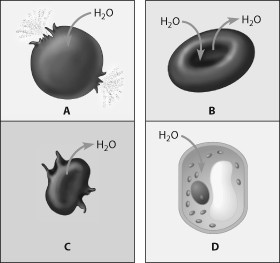____ would most likely lead to a rapid decrease in body temperature
a. Cutting the grass
b. Exercising
c. Falling through the ice
d. Getting the flu
e. Entering an air conditioned building
ANSWER: c
You might also like to view...
Treponema and Borrelia
A. are luminescent. B. are endosymbionts. C. are spirochaetes. D. are both easily grown on artificial media.
During the first meiotic division
A) spermatogonia and oogonia form. B) homologous chromosome pairs separate. C) homologous chromosome pairs join. D) the cell becomes diploid.
Meselson and Stahl's experiment followed
A) the distribution of different-weighted DNA over multiple generations of bacteria. B) the ability of a protease or nuclease to stop the transmission of DNA over generations. C) viruses injecting their DNA into bacteria. D) DNA sequences in people who are politically liberal compared to those who are sometimes politically conservative.
Which figure depicts an animal cell placed in a solution hypotonic to the cell?

A) cell A
B) cell B
C) cell C
D) cell D